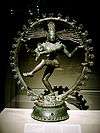Pancha Sabhai

Pancha Sabhai Sthalangal refers to the temples of Lord Nataraja, a form of Lord Shiva[1] where he performed the Cosmic Dance.[2] Pancha indicates Five, Sabhai means hall and Stala means place. All these temples are located in Tamil Nadu, India.
Nataraja
A few temples in Tamil Nadu are closely associated with Nataraja and have their own myths of dance along with the halls specific to their version of dance. The seven dances of Lord Siva can be recognised as the varied facts of single theme viz. the Beauty and Bliss of the Absolute. Herein lies the aesthetic fact of the dance. The seven dances are:
| Thandavam(Dance) | Hall | Temple | Location |
| Kali Thandavam | Rathinachabai | Vada aaranyeswarar Temple | Thiruvalangadu, Chennai |
| Ananda Thandavam | Porchabai | Natarajar Temple | Chidambaram |
| Sandhya Thandavam | Vellichabai | Meenakshi Amman Temple | Madurai |
| Muni Thandavam | Thamirachabai | Nellaiappar Temple | Tirunelveli |
| Tirupura Thandavam | Chithirachabai | Kutralanathar Temple | Courtallam |
It is significant to note that the above classification of Siva's dance, as mentioned in puranic literature are found within the geographical and cultural limit of Tamil Nadu. Of the seven dances, the seventh dance, Ananda Thandavam is representative and symbolic of the themes inherent in all other dances. The seventh is a composite ideal of the main tenets of Saiva Siddhanta Philosophy. The dance itself is a source of supreme aesthetic enjoyment of the beauty and bliss of god[3]
The Five Temples
| Category | Temple | Location | Element |
| Rathinachabai | Vada aaranyeswarar Temple | Thiruvalangadu, Chennai | Emerald |
| Porchabai | Natarajar Temple | Chidambaram | Gold |
| Vellichabai | Meenakshi Amman Temple | Madurai | Silver |
| Thamirachabai | Nellaiappar Temple | Tirunelveli | Copper |
| Chithirachabai | Kutralanathar Temple | Courtallam | Art |







